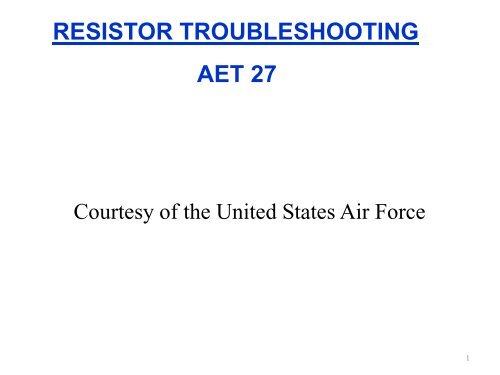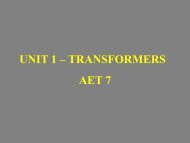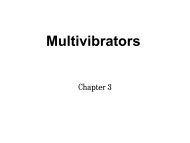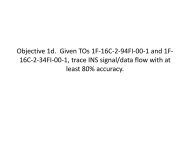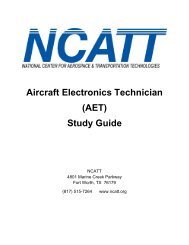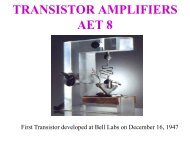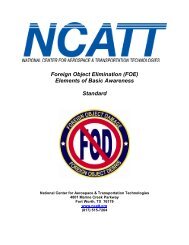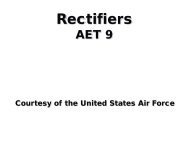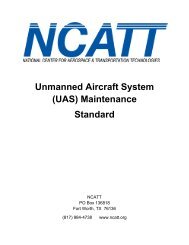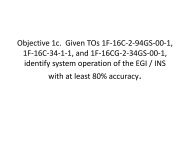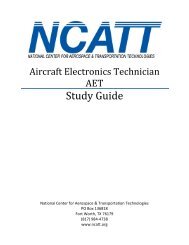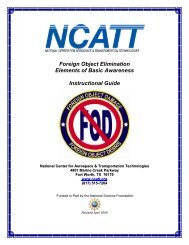Resistor Troubleshooting - NCATT
Resistor Troubleshooting - NCATT
Resistor Troubleshooting - NCATT
- No tags were found...
Create successful ePaper yourself
Turn your PDF publications into a flip-book with our unique Google optimized e-Paper software.
RESISTOR TROUBLESHOOTINGAET 27Courtesy of the United States Air Force1
INTRODUCTIONTired of throwing awaythose portable CDplayers that break onyou? Don’t have themoney to fix your carstereo?2
INTRODUCTIONWell, if you pay real closeattention to the methodsyou are about to learn ontroubleshooting, youmight be able to fix themyourself.3
INTRODUCTIONWe will now employ thewealth of knowledgegained over the past unitsto accomplish a primarytask of an electronicstechnician –troubleshooting to locate afaulty component.4
INTRODUCTIONObjective 8a:Use test equipment and a trainerto troubleshoot basic resistivecircuits IAW the PC checklist.Meas: PC(1) Safety/ORM(2) Series(3) Parallel(4) Series-parallel5
INTRODUCTIONLet’s begin our lesson with adiscussion of Safety &Operational Risk Management.6
PRESENTATIONSafety/ORMUse common sense.Adhere to all safety precautions andprocedures.Apply the six step ORM process ifapplicable.7
SERIES CIRUITPurpose of <strong>Troubleshooting</strong>?8
SERIES CIRUITFinding Faulty Components1. Visual InspectionCharred/Burnt componentsBad Solder ConnectionsBroken WiresPoor ContactsOpen Lamp FilamentsOpen Fuse9
SERIES CIRUITFinding Faulty Components2. Verifying Defective Components“Circuit Under Test”Resistance ChecksFusesLampsSwitchesCircuit Isolation10
SERIES CIRUITFinding Faulty Components3. Logic and Systematic<strong>Troubleshooting</strong> TechniquesMake a measurement only if you knowwhat a good reading should beMake as few measurements as possibleBest meter for circuit and circumstances11
<strong>Troubleshooting</strong><strong>Troubleshooting</strong> Series Circuits1. Open components2. Shorted components3. Components withchanged values12
Series Circuits ReviewParameterSeries CircuitParallel CircuitVoltageThe sum of the voltage drops across theindividual loads is equal to the sourcevoltage.The voltage across eachbranch is the same as thesource voltage.ResistanceThe total resistance is equal to the sumof the individual resistances.The total resistance is equalto the reciprocal of the sum ofthe reciprocals of theindividual resistances.CurrentThere is only one path for current to flow.The current at every point in the circuit isthe same.There is more than one pathfor current to flow.The total current is equal tothe sum of the branchcurrents.PowerThe total power consumed is equal to the sum of the powerconsumptions of the individual loads.13
<strong>Troubleshooting</strong> Series CircuitsOpen components:14
<strong>Troubleshooting</strong> Series CircuitsShorted Component15
<strong>Troubleshooting</strong> Series CircuitsShorted ComponentWhat happens to voltage, current, and resistance?16
<strong>Troubleshooting</strong> Series CircuitsChange in Value of R 3Given:Ea=120VR 1 =10kΩR 2 =15kΩR 3 =15kΩWhat happens ifR 3 decreases to10kΩ?What happens ifR 3 increases to35kΩ?R T =I T =E R1 =E R2 =E R3 =17
<strong>Troubleshooting</strong> Series Circuits0V35VVVEa =35VR1R3R2A0 mAV0V18
<strong>Troubleshooting</strong> Series Circuits18V26VVVEa =44VR1R3R2A22 mAV0V19
<strong>Troubleshooting</strong> Series Circuits12.5V 37.5VVVEa =100VR1=5kΩR3=20kΩR2=25kΩA2.5 mAV50V20
<strong>Troubleshooting</strong> Series Circuits24V0VVVEa =24VR1R3R2A0 mAV0V21
<strong>Troubleshooting</strong> Series Circuits74V0VVVEa =120VR1R3R2A10 mAV46V22
<strong>Troubleshooting</strong> Series Circuits0V0VVVEa =12VR1R3R2A0 mAV12V23
<strong>Troubleshooting</strong> Series Circuits36VV72VVEa =180VR1=10ΩR3=30ΩR2=20ΩA3.6AV72V24
<strong>Troubleshooting</strong> Series CircuitsSummary <strong>Troubleshooting</strong>Series CircuitsVoltageacrosscomponentVoltageacross othercomponentsResistanceacrosscomponentResistanceacross othercomponentsCircuitCurrentOPEN Source V Zero V Infinite Normal ZeroSHORT Zero V Increased V Zero ohms NormalW Increased Decreased Increased NormalW Decreased Increased Decreased Normal25
<strong>Troubleshooting</strong> Parallel CircuitsParallel Circuits:Not Easy to TroubleshootOpen componentsUsing conductanceShorted componentsBasic troubleshooting techniques26
<strong>Troubleshooting</strong> Parallel CircuitsVisual inspectionVerifying defective componentLogical and systematic troubleshootingtechniques27
Parallel Circuits ReviewParameterVoltageSeries CircuitThe sum of the voltage drops across theindividual loads is equal to the sourcevoltage.Parallel CircuitThe voltage across eachbranch is the same as thesource voltage.ResistanceThe total resistance is equal to the sumof the individual resistances.The total resistance is equalto the reciprocal of the sum ofthe reciprocals of theindividual resistances.CurrentThere is only one path for current to flow.The current at every point in the circuit isthe same.There is more than one pathfor current to flow.The total current is equal tothe sum of the branchcurrents.PowerThe total power consumed is equal to the sum of the powerconsumptions of the individual loads.28
<strong>Troubleshooting</strong> Parallel CircuitsOpen Components:Hard to troubleshoot since voltage is common.Open component in a parallel circuit can be found bycalculating conductance (G).Conductance is the reciprocal of resistance.The symbol for conductance is “G”.The unit of measure for conductance is “siemens”and the symbol for the unit of measure is “S”.29
<strong>Troubleshooting</strong> Parallel CircuitsCalculating Conductance:Recall:RT=1R1+1R21+1R3+ ....Conductance is reciprocal11 1 1G # = or G T = + + … or G T =R RR #1 2R3Resistance reciprocal1R # = or R T = 1 or R T =G #G 1 +G 2 +G 3 +…1G T1R T30
<strong>Troubleshooting</strong> Parallel CircuitsCalculating Conductance: Where’s the open?10 kW 15 kW 12 kWS 1Calculate R TR T = 4 kWCalculate G TG T = 250 µSMeasure R TR T = 6 kWCalculate Measured G TMeasured G T = 166.7 µSCalculated G T – Measured G T = G of open250μS – 166.67 = 83.3 µSCalculate R of open1 / 83.3 µS = 12 kWWhere’s the open?R 331
<strong>Troubleshooting</strong> Parallel CircuitsCalculating Conductance: Where’s the open?Practice:Ea = 62VR 1 = 4.8kΩR 2 = 6.2kΩR 3 = 3.6kΩMeas. R T = 2.06kΩAV V ΩS 1A A ACalculated R T =Calculated G T =Measured R T =Measured G T =G of open =R of open =Open =Did E R2 change do to the open?Did I 32R1 and I R3 change value?
<strong>Troubleshooting</strong> Parallel CircuitsCalculating Conductance: Where’s the open?Practice:Ea = 25VR 1 = 1.2kΩR 2 = 5.6kΩR 3 = 8.7kΩMeas. R T = 3.41kΩAV V ΩS 1A A ACalculated R T =Calculated G T =Measured R T =Measured G T =G of open =R of open =Open =Did E R3 change do to the open?Did I 33R1 and I R3 change value?
<strong>Troubleshooting</strong> Parallel CircuitsCalculating Conductance: Where’s the open?Practice:Ea = 120VR 1 = 10ΩR 2 = 15ΩR 3 = 12ΩMeas. R T = 5.45ΩAV V ΩS 1A A ACalculated R T =Calculated G T =Measured R T =Measured G T =G of open =R of open =Open =Did E R2 change do to the open?Did I 34R1 and I R3 change value?
<strong>Troubleshooting</strong> Parallel CircuitsCalculating Conductance: Where’s the open?Practice: Your OwnEa =R 1 =R 2 =R 3 =Meas. R T =AV V ΩS 1A A ACalculated R T =Calculated G T =Measured R T =Measured G T =G of open =R of open =Open =35
<strong>Troubleshooting</strong> Parallel CircuitsShorted ComponentsOne <strong>Resistor</strong> per BranchPractice:AEa = 35V5mAR 1 = 21kΩR 2 = 21kΩR 3 = 21kΩ0V0VV V Ω0ΩCalculate R T =Calculate I T =Calculate I R1 =Calculate I R2 =Calculate I R3 =Take MeasurementsWhere’s the short?A 5mA A0AAS 10A36
<strong>Troubleshooting</strong> Parallel CircuitsShorted ComponentsOne <strong>Resistor</strong> per BranchPractice:AEa = 12VR 1 = 20ΩR 2 = 30ΩR 3 = 12ΩMeas. R T = 7.5Ω1.6A0V0VV V Ω 0ΩCalculate R T =Calculate I T =Calculate I R1 =Calculate I R2 =Calculate I R3 =Take MeasurementsWhere’s the short?A 0A A1.6AAS 10A37
<strong>Troubleshooting</strong> Parallel CircuitsShorted ComponentsOne <strong>Resistor</strong> per BranchPractice: Your Own AEa =R 1 =R 2 =R 3 =Meas. R T =V V ΩCalculate R T =Calculate I T =Calculate I R1 =Calculate I R2 =Calculate I R3 =S 1A A ATake MeasurementsWhere’s the short?38
<strong>Troubleshooting</strong> Parallel CircuitsShorted ComponentsTwo <strong>Resistor</strong>s per BranchPractice:AEa = 12VR 1 = 10kΩR 2 = 15kΩR 3 = 10kΩ EaR 4 = 2kΩMeas. R T = 7.5ΩR 1 R 2R 3V V AΩCalculate R T = 4 kWCalculate G 1 = 100μSCalculate G 2 = 66.67μSCalculate G 3 (R 3 +R 4 ) = 83.33μSCalculate G T (G 1 +G 2 +G 3 ) = 250 µSMeasure R T = 3.75 kWMeasure G T = 266.67 µSCalculate G T R 3 only = 266.67 µSCalculate G T R 4 only = 666.67 µSAAR 4Compare R 3 and R 4 only G T to Measured G TShorted resistor is the one that DOES NOT match.39
<strong>Troubleshooting</strong> Parallel CircuitsShorted ComponentsTwo <strong>Resistor</strong>s per BranchPractice: Your Own AEa =R 1 =R 2 =R 3 =R 4 =Meas. R T =EaR 1 R 2R 3V V AΩCalculate R T =Calculate G 1 =Calculate G 2 =Calculate G 3 (R 3 +R 4 ) =Calculate G T (G 1 +G 2 +G 3 ) =Measure R T =Measure G T =Calculate G T R 3 only =Calculate G T R 4 only =AAR 4Compare R 3 and R 4 only G T to Measured G TShorted resistor is the one that DOES NOT match.40
<strong>Troubleshooting</strong> Parallel CircuitsChanged Value:R 11.2k ΩA30.5 mAR 25.6k ΩA5.3 mAV25VA20.8 mAEa25VA 4.5 mAR 38.7k ΩFinding a changed value component ina parallel circuit will normally requirethat individual components be isolatedand ohms checked to find the fault.Use the readings in the circuit above todetermine which resistor has changedand did it increase or decrease in value.<strong>Troubleshooting</strong> would be easy if wehad meters built in the circuit like theone above.How about R 3 decreased.41
<strong>Troubleshooting</strong> Parallel CircuitsChanged Value:A 26.5 mA R 1 V 42.6V8.1k ΩR 34.2kΩV28VR 51.8k ΩV16.4VA 5.3 mA A 6.67 mA A 9.09mAEa50VR21.4k Ω V 7.4VR 42.3k Ω V 22VR 63.7k Ω V 33.6VUse the readings in the circuit above todetermine which resistor has changedand did it increase or decrease in value.How about R 4 increased.42
TROUBLESHOOTINGSERIES-PARALLEL CIRCUITSeries-parallelBoth Circuit CharacteristicsSeries and Parallel circuit ComparisonCombine series and paralleltroubleshooting techniquesSeries circuit troubleshooting summary43
TROUBLESHOOTINGSERIES-PARALLEL CIRCUITSeries and Parallel Circuit ComparisonsParameterVoltageResistanceCurrentSeries CircuitThe sum of the voltage drops acrossthe individual loads is equal to thesource voltage.The total resistance is equal to thesum of the individual resistances.There is only one path for current toflow.The current at every point in thecircuit is the same.Parallel CircuitThe voltage across each branchis the same as the sourcevoltage.The total resistance is equal tothe reciprocal of the sum of thereciprocals of the individualresistances.There is more than one path forcurrent to flow.The total current is equal to thesum of the branch currents.PowerThe total power consumed is equal to the sum of the powerconsumptions of the individual loads.44
TROUBLESHOOTINGSERIES-PARALLEL CIRCUITEa140VDCR 18kΩR 2 R 320kΩ30kΩS 1Normal/FaultedR e =R T =I T =E R1 =E R2 =E R3 =If:R 2 OpenR 3 ShortedR 3 Changed W45
TROUBLESHOOTINGSERIES-PARALLEL CIRCUITS 175VIf:R 5 OpenR 1 ShortedR 5 Changed W5Ω15Ω15Ω 12Ω 20ΩNormal/FaultedR e =R T =I T =E R1 =E R2 =E R3 =E R4 =E R5 =46
RESISTOR TROUBLESHOOTINGObjective 8a:AppraisalUse test equipment and a trainerto troubleshoot basic resistivecircuits IAW the PC checklist.47
RESISTOR TROUBLESHOOTING70. One of the first things you shoulddo to isolate a faulty component isto perform .a. resistance measurementsb. current measurementsc. voltage measurementsd. a visual inspection48
RESISTOR TROUBLESHOOTING71. When performing an ohms check,an open is indicated by a reading of________ .a. 1000 MΩb. 10 MΩc. 0 Ωd. ∞ Ω49
RESISTOR TROUBLESHOOTING72. When making measurements to finda faulty component, you shouldperform as measurementsas possible.a. fewb. many50
RESISTOR TROUBLESHOOTING73. The symbol for conductance isa. Gb. Ic. Rd. P51
RESISTOR TROUBLESHOOTING74. The unit of measurement forconductance is ________.a. siemensb. amperec. voltd. ohm52
RESISTOR TROUBLESHOOTING75. When performing an ohms check, ashort is indicated by a reading of________ .a. 1000 MΩb. 10 MΩc. 0 Ωd. ∞ Ω53
RESISTOR TROUBLESHOOTING76. Total conductance can be used tofind an open in a series circuit.a. trueb. false54
RESISTOR TROUBLESHOOTINGR 1R 2R 3EaR 477. In the circuit above, if R 4 shorts thecurrent through R 2 will __________.a. remain the sameb. decreasec. increase55
RESISTOR TROUBLESHOOTINGR 1R 2R 3EaR 478. In the circuit above, if R 2 opens thecurrent through R 2 will be ________.a. 10 mab. 0 mwc. 0 Vd. 0 A56
RESISTOR TROUBLESHOOTINGR 1R 2R 3EaR 479. In the circuit above, if R 1 opens thecurrent through R 3 will be _______.a. 0 Ab. 0 Vc. 0 mwd. 10 ma57
AppraisalLet’s check your Answers.58
RESISTOR TROUBLESHOOTING70. One of the first things you shoulddo to isolate a faulty component isto perform .a. resistance measurementsb. current measurementsc. voltage measurementsd. a visual inspection59
RESISTOR TROUBLESHOOTING71. When performing an ohms check, anopen is indicated by a reading of________ .a. 1000 MΩb. 10 MΩc. 0 Ωd. ∞ Ω60
RESISTOR TROUBLESHOOTING72. When making measurements to finda faulty component, you shouldperform as measurementsas possible.a. fewb. many61
RESISTOR TROUBLESHOOTING73. The symbol for conductance isa. Gb. Ic. Rd. P62
RESISTOR TROUBLESHOOTING74. The unit of measurement forconductance is ________.a. siemensb. amperec. voltd. ohm63
RESISTOR TROUBLESHOOTING75. When performing an ohms check, ashort is indicated by a reading of________ .a. 1000 MΩb. 10 MΩc. 0 Ωd. ∞ Ω64
RESISTOR TROUBLESHOOTING76. Total conductance can be used tofind an open in a series circuit.a. trueb. false65
RESISTOR TROUBLESHOOTINGR 1R 2R 3EaR 477. In the circuit above, if R 4 shorts thecurrent through R 2 will __________.a. remain the sameb. decreasec. increase66
RESISTOR TROUBLESHOOTINGR 1R 2R 3EaR 478. In the circuit above, if R 2 opens thecurrent through R 2 will be ________.a. 10 mab. 0 mwc. 0 Vd. 0 A67
RESISTOR TROUBLESHOOTINGR 1R 2R 3EaR 479. In the circuit above, if R 1 opens thecurrent through R 3 will be _______.a. 0 Ab. 0 Vc. 0 mwd. 10 ma68
CONCLUSIONSummary:1. Safety/ORM2. Series Circuit <strong>Troubleshooting</strong>3. Parallel Circuit <strong>Troubleshooting</strong>4. Series-parallel Circuit<strong>Troubleshooting</strong>69
CONCLUSIONRemotivation:The primary task of an electronictechnician is to locate and replacedefective components. The basic mathand electronic principles learned inBlock I are essential to accomplishingthis vital task. Remember what you havelearned! This material is one of thebuilding blocks you will need tosuccessfully complete this course.70
CONCLUSIONAssignment:Direct students to performreading and workbookassignments as applicable.(Assignments may be deferredto the end of the day)71
CONCLUSIONClosure:This concludes the instructionfor Block I; DC Circuits.72


